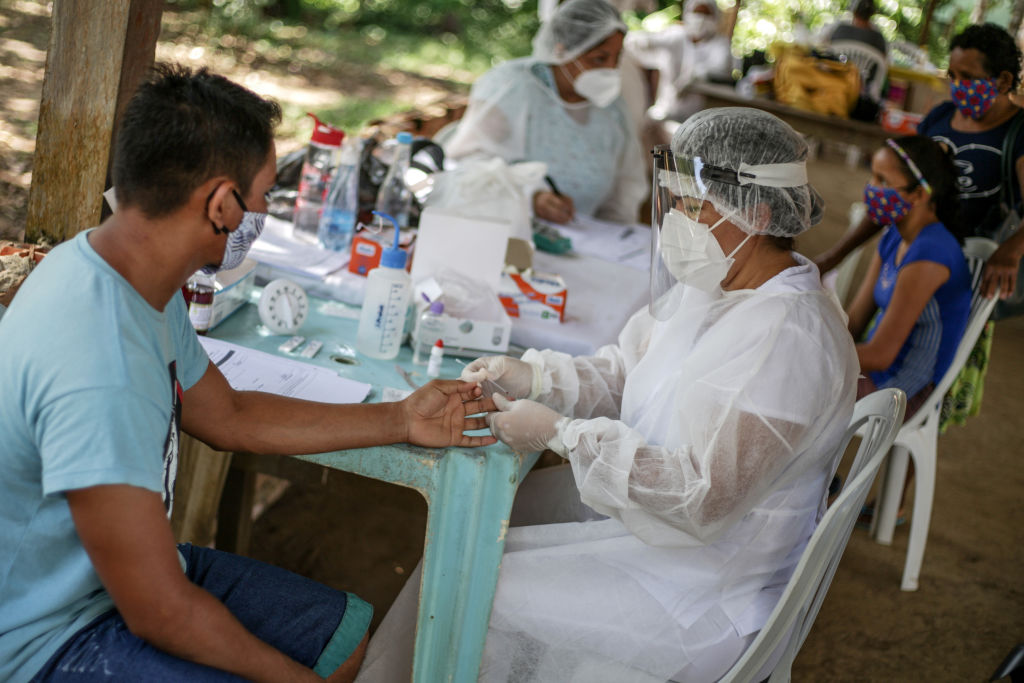Throughout the COVID crisis, the international response to the disease has rested on a simple assumption: that none of us have any resistance to it, being caused by a novel virus. Therefore, if allowed to let rip through the population, the virus would exponentially spread until around 60-70 percent of us had been infected and herd immunity was reached. This was the assumption behind Neil Ferguson’s paper in March, claiming that COVID-19 would kill 500,000 Britons if nothing was done and 250,000 if the UK government carried on with the limited mitigation polices it was then following.
Yet real world data has challenged this assumption. First came the accidental human experiment of the Diamond Princess cruise ship, where in January the disease spread unnoticed among 3,711 passengers and crew in the closed environment of a ship. But when all those people were tested for the disease, only 19 percent turned out to have been infected. Similarly, as reported in The Spectator in March, a study of 1,286 people in the southern Chinese city of Shenzhen revealed that only 14.9 percent of people who shared an apartment with someone later found to be suffering from COVID-19, had picked up the infection themselves.
In New York City, a runaway epidemic seems to have left after antibody tests on a sample of the population revealed 21 percent of the population had been infected. In London, the epidemic appears to have retreated after 17 percent were infected.
There is now another piece of powerful evidence suggesting that the assumption we are all susceptible to COVID-19 could be wrong. The Amazonian city of Manaus has witnessed a remarkable retreat in what had seemingly been an uncontrolled epidemic among its two million population. Excess deaths, which had been running at 120 a day in May, have dropped away to virtually nothing, allowing the city’s emergency field hospital to be closed. Interestingly, the retreat of the virus occurred once 20 percent of the population appeared to have been infected.
In the case of New York and London, there was the complication of lockdown — could infection levels have been frozen around the 20 percent level thanks to our restrictions, rather than as a result of any natural resistance? But in the case of Manaus, there are no such complications: no lockdown restrictions were ever imposed. The epidemic seems to have died away of its own accord. The virus staged a similar retreat in the Ecuadorean city of Guayaquil, although the proportion infected there is notably higher, at 33 percent.
The assumption that we are equally susceptible to COVID-19 is not shared by all virologists or epidemiologists. As reported here in May, but not widely covered elsewhere, a team led by Gabriella Gomes of Strathclyde University and the Liverpool School of Tropical Medicine has produced its own model, taking into account that humans have widely different patterns of social interaction. Once a virus has infected those with a high level of social interaction, it finds it much more difficult to spread. As a result, according to Gomes’s model, the percentage of the population that needs to be infected before effective herd immunity is reached drops from 60 percent to between 10 and 20 percent.
***
Get a digital subscription to The Spectator.
Try a month free, then just $3.99 a month
***
There has also been an increasing amount of evidence suggesting that humans may have acquired some degree of immunity to SARS-CoV-2 through exposure to other coronaviruses. Again, this real-world evidence has been available since May, when it was reported here on a couple of occasions.
Yet the approach of many governments towards COVID-19 appears to be trapped by modeling based on the assumption of universal susceptibility and a herd immunity threshold of 60 percent. Perhaps it is time for governments to seek advice from a wider range of sources and begin looking at real world evidence, rather than just models.
It ought to be added that Manaus does not provide a great advert for doing nothing at all to combat the spread of COVID-19. Before the city reached an apparent infection rate of 20 percent, hospitals had been overwhelmed and it had recorded COVID-19 deaths of over 3,300 people — one in 600 of the population. Nevertheless, its experience falls a long way short of the projections made by Ferguson, whose worst-case scenario would have seen 1 in 130 Britons die.
This article was originally published on The Spectator s UK website.


















